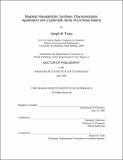| dc.contributor.advisor | Moungi G. Bawendi. | en_US |
| dc.contributor.author | Tracy, Joseph B. (Joseph Benjamin) | en_US |
| dc.contributor.other | Massachusetts Institute of Technology. Dept. of Chemistry. | en_US |
| dc.date.accessioned | 2006-12-18T19:04:59Z | |
| dc.date.available | 2006-12-18T19:04:59Z | |
| dc.date.copyright | 2005 | en_US |
| dc.date.issued | 2005 | en_US |
| dc.identifier.uri | http://dspace.mit.edu/handle/1721.1/32426 | en_US |
| dc.identifier.uri | http://hdl.handle.net/1721.1/32426 | |
| dc.description | Thesis (Ph. D.)--Massachusetts Institute of Technology, Dept. of Chemistry, 2005. | en_US |
| dc.description | This electronic version was submitted by the student author. The certified thesis is available in the Institute Archives and Special Collections. | en_US |
| dc.description | Includes bibliographical references. | en_US |
| dc.description.abstract | We systematically investigated the magnetic properties of colloidal cobalt nanoparticles after three extents of oxidation: The native sample has a thin (1.0 nm) CoO shell and exhibits no exchange biasing. The purposefully partially oxidized sample has a thicker CoO shell (3.2 nm), and is exchange biased. The sample fully oxidized to CoO looses exchange biasing. Three distinct magnetic properties that result from the finite-thickness antiferromagnet shell exchange coupled to a finite-size ferromagnet core, and from crystal and stoichiometric defects, were observed: (1) an enhancement of the thermal stability of the orientation of the magnetic moment due to exchange biasing in the partially oxidized sample, (2) a low temperature paramagnetic response in the partially and fully oxidized samples due to crystallographic and stoichiometric defects in the CoO shell, and (3) an asymmetry in the field-dependent magnetization for the partially oxidized sample at low temperature due to small clusters of Co in a diffusion layer around the Co core. We interpret these effects using a simple phenomenological model and propose a method for fabricating magnetic media using exchange biased nanoparticles. We further investigated the defect moments in the CoO shell and their role in exchange biasing. The distribution of the defect moments' melting temperatures was measured, and most melt below 50 K, which is well below the temperature at which the CoO lattice moments freeze. Experiments in the partially oxidized sample, in which the polarity of the biasing field was switched during cooling, show that the defect moments pin the Co core more strongly than the CoO lattice and thereby dominate exchange biasing at low temperature. | en_US |
| dc.description.abstract | (cont.) At higher temperatures, the CoO defects are paramagnetic and cannot contribute to pinning, and the CoO lattice controls exchange biasing. By switching the field polarity and switching to zero field during cooling, exchange shift and coercivity tunability was demonstrated. We interpret these results using the domain state model of exchange biasing. We also present results for the preparation and characterization of [gamma]-Fe₂0₃ and FePt nanoparticles. | en_US |
| dc.description.statementofresponsibility | by Joseph B. Tracy. | en_US |
| dc.format.extent | 172 p. | en_US |
| dc.format.extent | 9833617 bytes | |
| dc.format.extent | 9832073 bytes | |
| dc.format.mimetype | application/pdf | |
| dc.format.mimetype | application/pdf | |
| dc.language.iso | eng | en_US |
| dc.publisher | Massachusetts Institute of Technology | en_US |
| dc.rights | M.I.T. theses are protected by copyright. They may be viewed from this source for any purpose, but reproduction or distribution in any format is prohibited without written permission. See provided URL for inquiries about permission. | en_US |
| dc.rights.uri | http://dspace.mit.edu/handle/1721.1/32426 | en_US |
| dc.rights.uri | http://dspace.mit.edu/handle/1721.1/7582 | |
| dc.subject | Chemistry. | en_US |
| dc.title | Magnetic nanoparticles : synthesis, characterization, applications and systematic study of exchanging biasing | en_US |
| dc.type | Thesis | en_US |
| dc.description.degree | Ph.D. | en_US |
| dc.contributor.department | Massachusetts Institute of Technology. Department of Chemistry | |
| dc.identifier.oclc | 61717738 | en_US |
